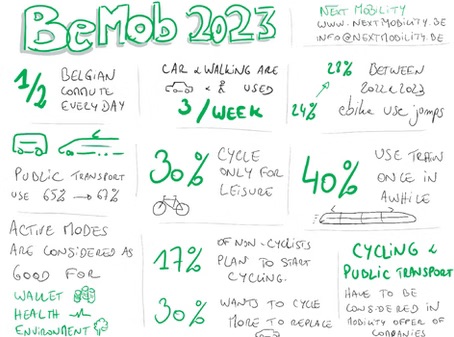📊 Key Findings from the latest BeMob report published by SPF Mobilité that highlights the Belgian Mobility Trends:
1️⃣ Mobility Matters: Half of Belgians commute daily, with only 13% seeking to reduce travel in the future. Mobility remains a cornerstone of Belgian life. 🏃♂️💼
2️⃣ Modes of Travel: Cars and walking dominate, with public transport (67% of users) and cycling (57% of users) emerging as viable alternatives. 🚗🚶♂️🚲
3️⃣ Electric Bike Surge: Electric bike usage jumps from 24% to 28%, outpacing non-electric bikes, especially in rural areas. ⚡🚲
4️⃣ Post-COVID Trends: Public transport usage sees a slight rise (65% to 67%), along with carpooling (23% to 25%). Adaptations post-pandemic are evident. 🦠🚌
5️⃣ Cycling Dynamics: 30% of cyclists ride purely for leisure, notably higher in Wallonia (67%) than in Flanders (21%). Understanding cycling habits is crucial. 🚴♂️🌳
6️⃣ Train Usage Potential: Over half take the train annually, yet most are sporadic users (40%). There’s untapped potential for a modal shift with encouragement. 🚉💡
7️⃣ Active Modes and Sustainability: Belgians perceive walking and cycling as affordable, healthy, and eco-friendly. Public transport is seen as safer and cheaper than cars. 🌱🌍
8️⃣ Shift Towards Cycling: A significant number express intent to cycle more, with cars being the most likely mode to be replaced. New cycling trips include recreational outings. 🚲🎒
🔄 Evolution Insights: The mobility landscape saw notable changes between 2022 and 2023. Despite expectations of modest shifts, two significant trends emerged. Firstly, there’s a slight uptick in the usage of crisis-impacted modes like public transport and carpooling. Secondly, the remarkable growth in electric bike usage stands out, with a 4% increase from 24% to 28%, surpassing traditional bikes. This surge is particularly pronounced in rural areas, indicating a broader acceptance of sustainable transportation solutions. 📈🔍
🚀 Takeaway: For HR managers, CEOs, CFOs, mobility and fleet managers, these insights provide valuable data for crafting employee mobility programs, corporate sustainability initiatives, and fleet management strategies. Embracing sustainable modes of transport not only aligns with environmental goals but also promotes employee well-being and cost-efficiency. 💼💡
💬 Join the Discussion: How can businesses leverage these trends to enhance employee mobility and sustainability efforts? Share your thoughts!
